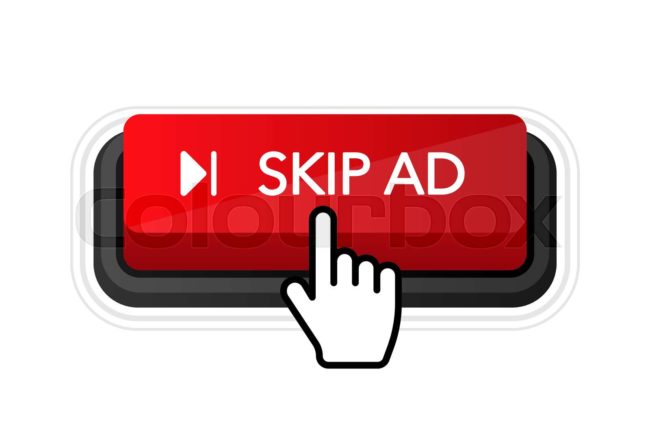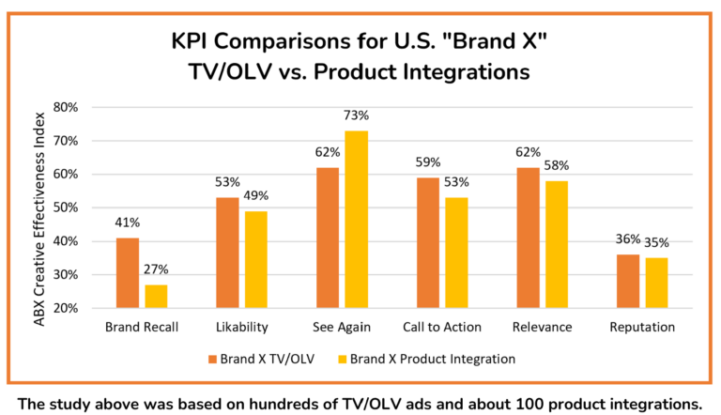Product Integration/Placement Explodes vs. Traditional Ads
Research Findings and a New Way of Measuring Success
 Product Placement and Integration are blasting through the strong barriers erected by audiences against traditional advertising and on-demand content.
Product Placement and Integration are blasting through the strong barriers erected by audiences against traditional advertising and on-demand content.
Numerous studies show why traditional or digital advertising on their own may not give brands the results they want. A few examples include:
- A January 2022 article in TVTech reported that 76% of viewers either don’t watch TV ads at all, or watch on mute.
- A Sept. 2021 article in The Conversation reported 90% of online viewers skip videos before they even begin.
- A March 2022 study by S&P Global found that approximately 37% of subscribers of selected hybrid video-on-demand platforms selected the ad-free tier rather than the ad-supported one.
So, marketers are turning to product placement and integration to capture attention. In fact, product placement/integration spending for 2021 jumped 12.3% to almost $23 billion globally, and 13% to almost $13 billion in the US according to a new PQ Media study featured in Mediapost. Seventy percent of this increase came from placements/integration in TV followed by those in digital media, music, film, video games and print. It’s a new day indeed.
However, what really works is combining placements/integrations with traditional advertising, or combining the two in online and offline media, in the same campaign. An Aug. 2022 article quoted Erin Schmidt, chief of product placement at BEN: “If you’re only running a 30-second spot, if you’re only doing integration, the impact isn’t as big” … “But if you are doing both, in most cases, you’re seeing a significant impact [and] a significant increase in attribution.”
Unforgettable Product Placements/Integrations
The product placements/integrations technique started in the early 1900’s when soaps and tobacco companies sponsored shows in which characters would use their products. In 1956, the movie “Around the World in 80 Days” used a real-life ship on which to place the main character. Just a few recent exceptional campaigns included:
- Reese’s Pieces sales increased 60% during the first three weeks of Spielberg’s “E.T.”1
- Etch a Sketch sales increased by 4,500% and Mr. Potato
- Head by 800% while Slinky’s received 20,000 orders, thanks to great placements in “Toy Story”.2
- General Mills brand Old Paso and Honey Nut Cheerios enjoyed sales lifts of 24% and 29% from product integrations in linear TV from 2019 – 2021 according to a new study reported in AdAge for BEN3.
- And of course, many more.
Is Product Placement/Integration Always Better than TV Spots?

Not always, according to a great deal of research on the effectiveness of placements and integrations. Just a few recent studies include:
In 2018, a study from Wroclaw, Poland, found that product placement/integrations yielded better recall results than TV commercials when viewing in the real-world environment. However, TV spots do better when viewed in a research laboratory.4
In 2019, a University of Washington study looked at product placement effects on store sales for CPG and found that product placement has a small, positive effect on demand overall, and that it appears to be more effective at driving sales than TV spots for soda and some of the other brands tested, but not for coffee. In other words, the magnitude of placement elasticities varies across categories, brands, price and more.
ABX Advertising Benchmark Index has been testing product integration globally for years from a purely creative standpoint, and has found that, product integration and standard advertising are equally effective across all media types.
For example, a recent ABX study for a major global entertainment company (Brand X) showed TV spots scored higher in almost all KPIs except for Brand Recall (TV was best), while product integration scored highest for See Again. But almost all of the other KPIs for the two groups were not statistically different. Brand Recall for product integration is lower, perhaps because of its subtle integration into programming.


The study above was based on hundreds of TV/OLV ads and about 100 product integrations.
ABX measures the creative impact of product integration and compares it directly to traditional media due to its global methodology that measures all creative in the same way.
Gary Getto, President of ABX, explains, “In testing creative globally, we can see how product integration compares to other media types and determine its effectiveness across a range of KPIs. Does the brand register with the audiences? Have perceptions changed? Which actions are likely to be taken? Which integrations and shows work best, etc. We can quantify the value of product integrations for any brand or business; identify where it fits in overall plans; and provide insights that will make future product integrations successful with results in 24-48 hours at affordable price points.”
But the devil is in the details. As stated above in the University of Washington Study, the magnitude of placement elasticities really defines the success of a program.
- Remember the scale of a placement/integration and how much ancillary activity is running simultaneously, such as a social media campaign, WOM, sweepstakes, traditional ads, etc. Product placement/integration with on- and offline ad support tend to have better results than placements in just one media type.
- Placements early-in-show, with multiple product placements and in-show integrations that fit into the story, impacts product familiarities. Each piece of creative drives brand recall and CTAs.
- External forces such as where the product is placed, how many viewers see the integration, how many times it appears, and whether a major character or personality is using it … all are factored into creative testing.
- Understand which types of shows work best? What media – broadcast, cable, streaming, digital, radio? Should the integration be funny, avant-garde, sentimental, features oriented or practical? Were the shows about sports, news, sports, drama, comedy, soap? Was it seen or heard in a car, at home, in social settings?
- Is the product itself suited for placement (i.e. soda yes, coffee no)? Are the price points reasonable? Does the brand compare well to other products in the category?

Final Thoughts and Tips
Product integration is not a silver bullet; creatively it is about as effective as a commercial but there are variables that make it effective. For instance, 40% of TV ads underperform creatively, 76% of viewers pay little or no attention to TV ads, and 90% skip past online video ads. With odds like those for commercials, product placement/integration is ideal.
An outstanding study by Fossen and Schweidel5 investigated how “prominent product placement activities – especially verbal placements – relate to immediate increases in online WOM and website traffic for the placed brand with some evidence of decreasing returns at high levels of prominence.” In other words, be careful not to overload a show with too many placements or ads, especially too close together.
Furthermore, they write, “Our data is limited in that it is not single-source nor does it allow us to directly observe an individual’s behavior across devices and platforms. Such single-source, cross-device or cross-platform data would facilitate gaining a more complete picture of content consumption and exposure to marketing.”
And that’s exactly what ABX does. It provides single-source, cross-device, and cross-platform data in the form of creative testing that is available within 24 hours and useful for immediate learnings on how to make the next product integration better.
1 Product Placement on Television: An Effective Means of Breaking Through the Clutter?
3 Study executed by TV analytics firm 605
5 “Measuring the Impact of Product Placement with Brand-related Social Media Conversations and Website Traffic” © 2018 Beth L. Fossen and David A. Schweidel for Marketing Science Institute.
